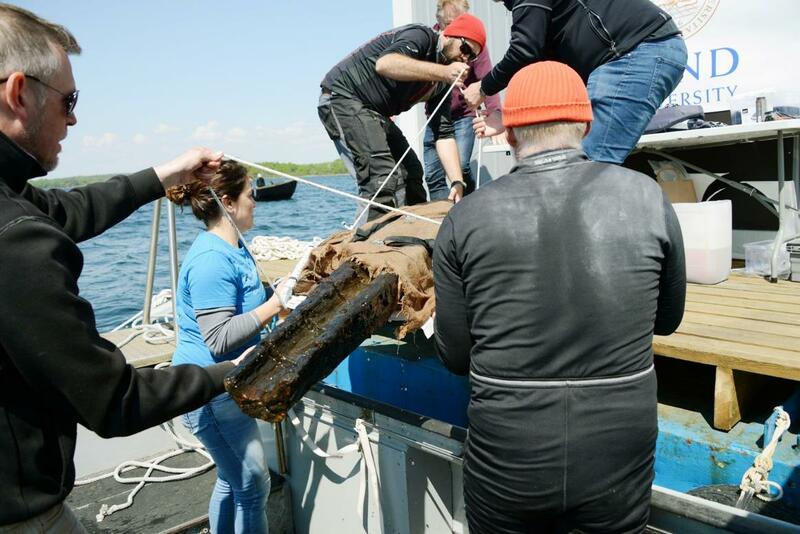Identifier
Title
Description
Noteworthy finds in the trench are numerous crossbow elements, representing as many as eight or nine weapons, with four nearly complete except for their composite prods and iron triggers. Initial interpretation of the crossbows suggests a central European origin, perhaps German/Austrian, dating to the second half of the 15th century. The concentration of crossbows in the trench suggests that small arms were stored in this area of the ship (figure 8). It is likely that additional undiscovered crossbows are adjacent to the trench to the northwest and northeast; two of the recovered crossbows (A173 and A249) extended beyond the arbitrary confines of the trench, requiring the excavators to work several centimeters beyond the trench border to recover the exposed artifacts.
Crossbow accoutrements recovered in context with the weapons include a variety of quarrels intact except for their metal points, a possible wooden quiver and its bottom (A21 and A43), and two birch bark panels decorated with animal and floral motifs (A17 and A103). The birch bark panels might be coverings for the composite prods of crossbows. Composite prods were made from laminated sinew, horn, wood, sometimes baleen, adhered with glue, and wrapped with birch bark for moisture resistance. The best glues were made from sturgeon swim bladders; this provides additional context for the sturgeon in the cask recovered in 2019. Alternatively, the birch bark panels might be decorative elements of an undiscovered object such as a bolt box; see for instance the “Box For Crossbow Bolts (Bolzenkasten), Probably Made for William IV, Duke of Bavaria (r. 1508–50)” Metropolitan Museum of Art Accession Number: 69.199.
Both Gribshunden panels exhibit swirling floral patterns. A peacock is one element of the first panel (A17) (see image appendix A). Exotic imported animals were desirable features of royal courts and elite landscapes in the medieval period. Two peacocks were buried in the Gokstad ship, circa 900 AD, and osteoarchaeological remains of a peacock have been excavated from a 15th century context in Lund, Skåne. The entire A17 motif appears to be oriented vertically (ie: ‘portrait’ as opposed to ‘landscape’). The decoration of the second birch bark panel (A103) is arranged horizontally, with a “T” shaped incision (see image appendix B). It features an equine, possibly a unicorn. Another animal, perhaps a dog, is positioned near its front legs. Birds are apparent among the floral swirls. This could be a hunting scene. Hunting motifs are known from crossbows stocks, but no examples survive of similar motifs on prods. If the animal is a unicorn, it opens a variety of interpretive possibilities which will be explored by the Gribshunden project’s researchers in collaboration with medieval art historians.
The motifs of both panels are partially obscured and degraded. After conservation, we will attempt to reveal the entire pattern by non-invasive methods. These techniques may include Raman spectroscopic imaging, X-Ray Fluorescence, and/or dynamic illumination.
In the northeastern portion of the trench, at the locus of crossbow, portions of a “bollock dagger” were recovered. These include the weapon’s distinctive shaft and spherical protuberances (A144) and a patterned metal end cap of the handle (A152).
Along the bottom of the trench at its midpoint, excavation exposed a portion of an apparently cylindrical iron rod or pipe. It may be a handgun similar to a weapon on display in the Danish National Museum. It runs fore-and-aft through the trench and beyond on both sides. This object was left undisturbed and not assigned an artifact number.
In addition to the large artillery piece discovered off the port quarter, the excavation revealed other artifacts relating to the main guns. In the southern corner of the trench several pieces of light three-strand twisted cordage about 1 cm in diameter were recovered (A72). It may be a very light rope for general use, but it may be fuse cord used to light the artillery charges. Strengthening this interpretation is that immediately adjacent to the cord an intact linstock (A73) was recovered from underneath one of the wooden casks (figure 9). The handle of the linstock bears an incised symbol: two vertical lines crossed diagonally by a single line. This may be the mark of the gun captain. These are the earliest known examples of a linstock and fuse cord.
Several disarticulated brass rings, presumably from mail armor, were recovered from the trench. While most of these were the usual riveted wire loops, two were solid circles apparently cut from brass sheet (figure 10). These may have served a different and unknown function, unrelated to armor.
Set 3DHop scene
Record creator
Linked resources
| GH2021 Report 2 |


















| Plane | Position | Flip |
| Show planes | Show edges |
0.0
[ 0 , 0 , 0 ]






